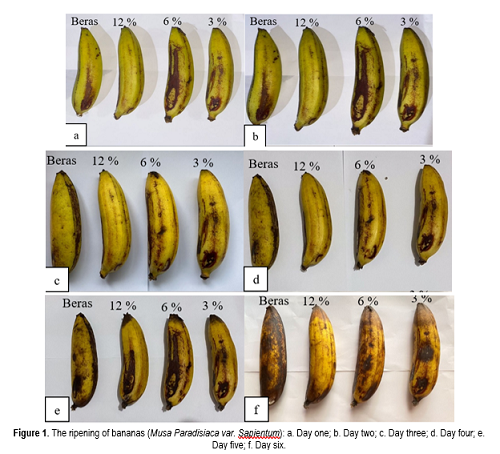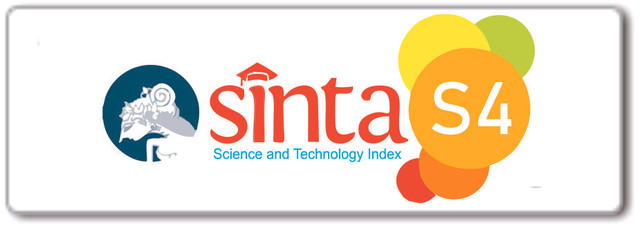Effect of calcium carbide on the rate of ripening of Ambon Bananas (Musa paradisiaca Var. Sapientum (L). Kunt)
Organoleptic Test
Abstract
Bananas are one of the most widely consumed sources of nutrients in Indonesia. Generally, bananas are consumed fresh and processed into various snacks. This leads to an increased demand for bananas in the market. However, the natural ripening process takes 7-8 days after harvest, which is a long time to meet consumer demand. One solution is to use calcium carbide to accelerate fruit ripening. The reason for using calcium carbide is that it is readily available and inexpensive, so banana producers use carbide as a fruit ripening agent. The objective of this study was to determine the effects of calcium carbide on fruit ripening of Ambon bananas. The method used was a laboratory experiment with a post-test-only control group design. There were three treatments with calcium carbide concentrations of 12%, 6%, and 3%, and positive control, namely rapining with rice. Data were analyzed descriptive qualitative by collecting, presenting, reducing, and conclusions. The process of fruit ripening can be observed using the variables of color, texture and aroma. The results obtained were differences in color, texture, and aroma at concentrations of 12%, 6%, and 3% based on the length of aging. Based on the color parameter, the concentration of 6% and 12% showed a blackish yellow/brown color, while the concentration of 3% was yellow with black spots. The texture parameters of the 6% and 12% concentrations had a very soft texture, while the 3% concentration had a smooth texture. The aroma parameters of the 12%, 6%, and 3% concentrations had a rancid aroma on day six, while days one, two, and three were fragrant. The conclusion is that using calcium carbide at different concentrations affects the rate of fruit ripening. The higher the concentration of calcium carbide used, the faster the respiration rate of the bananas, thus initiating the ripening process
Downloads
References
Akter, B., Talukder, N., Bari, L., & Rabeta, M. S. (2020). Evaluation of ripening period, shelf-life, and physiological properties of Sobri (Musa cavendish) and Sagor (Musa oranta) bananas triggered by ethephon and calcium carbide. Food Research, 4(2), 407-412. https://doi.org/10.26656/fr.2017.4(2).290
Arif, A. Bin, Diyono, W., Syaefullah, E., Suyanti, & Setyadjit. (2014). Optimalisasi cara pemeraman buah cempedak (Artocarpus champeden). Journal Infromatika Pertanian, 23, 35-46.
Brizzolara, S., Manganaris, G. A., Fotopoulos, V., Watkins, C. B., & Tonutti, P. (2020). Primary metabolism in fresh fruits during storage. Frontiers in Plant Science, 11, 1–16. https://doi.org/10.3389/fpls.2020.00080
Damayanti, A., Karsiningsih, E., & Muntoro, M. (2023). Analysis of attitude and consumer preferences to purchase decisions of banana fruit in traditional markets Pangkalpinang City. JIA (Jurnal Ilmiah Agribisnis): Jurnal Agribisnis Dan Ilmu Sosial Ekonomi Pertanian, 8(1), 65–72. https://doi.org/10.37149/jia.v8i1.428
Firmansyah, Sabahannur, & Alimudin, S. (2022). Uji dosis karbid (CaC2) dan jenis kemasan terhadap waktu pematangan dan mutu buah pisang raja bulu (Musa paradisiaca L. var sapientum). Jurnal AGrotekMAS, 3(3), 9-19.
Hapsari, L., & Lestari, D. A. (2016). Fruit characteristic and nutrient values of four Indonesian banana cultivars (Musa spp.) at different genomic groups. Agrivita, 38(3), 303–311. https://doi.org/10.17503/agrivita.v38i3.696
Harto, A. B., Prastiwi, P. A. D., Ariadji, F. N., Suwardhi, D., Dwivany, F. M., Nuarsa, I. W., & Wikantika, K. (2019). Identification of banana plants from unmanned aerial vehicles (UAV) photos using object based image analysis (OBIA) method (a case study in Sayang Village, Jatinangor District, West Java). HAYATI Journal of Biosciences, 26(1), 7–14. https://doi.org/10.4308/hjb.26.1.7
Hasanah, R., Daningsih, E., & Titin. (2017). The analysis of nutrient and fiber content of banana (Musa paradisiaca) sold in Pontianak, Indonesia. Biofarmasi Journal of Natural Product Biochemistry, 15(1), 21–25. https://doi.org/10.13057/biofar/f150104
Hastuti, Purnomo, Sumardi, I., & Daryono, B. S. (2019). Diversity wild banana species (Musa spp.) in Sulawesi, Indonesia. Biodiversitas, 20(3), 824–832. https://doi.org/10.13057/biodiv/d200328
Indarto, & Murinto. (2017). Deteksi kematangan buah pisang berdasarkan fitur warna citra kulit pisang menggunakan metode transformasi ruang warna HIS ( Banana fruit detection based on banana skin image features using HSI color space transformation method ). Jurnal Ilmiah Informatika, 5, 15–21.
Iqbal, N., Khan, N. A., Ferrante, A., Trivellini, A., Francini, A., & Khan, M. I. R. (2017). Ethylene role in plant growth, development and senescence: interaction with other phytohormones. Frontiers in Plant Science, 8, 1–19. https://doi.org/10.3389/fpls.2017.00475
Kemenko Perekonomian RI. (2022). Terus dorong peningkatan konsumsi buah nusantara, pemerintah gelar kembali gelar buah nusantara (GBN) ke-7 Tahun 2022. Ekon.Go.Id, HM.4.6/435/SET.M.EKON.3/08/2022. Kemenko Perekonomian RI. from https://www.ekon.go.id/publikasi/detail/4450/terus-dorong-peningkatan-konsumsi-buah-nusantara-pemerintah-gelar-kembali-gelar-buah-nusantara-gbn-ke-7-tahun-2022
Khafid, A., Nurchayati, Y., Hastuti, E. D., & Setiari, N. (2023). Vitamin C and total soluble solid content of crystal guava at different storage duration and ripeness. Kultivasi, 22(2), 147–156. https://doi.org/10.24198/kultivasi.v22i2.44124
Kuang, J. F., Wu, C. J., Guo, Y. F., Walther, D., Shan, W., Chen, J. Y., Lu, W. J. (2021). Deciphering transcriptional regulators of banana fruit ripening by regulatory network analysis. Plant Biotechnology Journal, 19(3), 477–489. https://doi.org/10.1111/pbi.13477
Lufu, R., Ambaw, A., & Opara, U. L. (2020). Water loss of fresh fruit: Influencing pre-harvest, harvest and postharvest factors. Scientia Horticulturae, 272(May). https://doi.org/10.1016/j.scienta.2020.109519
Maduwanthi, S. D. T., & Marapana, R. A. U. J. (2019). Induced ripening agents and their effect on fruit quality of banana. International Journal of Food Science, 2019. https://doi.org/10.1155/2019/2520179
Markiah, Hustiany, R., & Rahmi, A. (2020). Upaya Mempertahankan Umur Simpan Pisang Kepok Dengan Kemasan Aktif Berbahan Arang Aktif Cangkang Kelapa Sawit. Jurnal Teknologi Industri Pertanian, 30(2), 198–208. https://doi.org/10.24961/j.tek.ind.pert.2020.30.2.198
Oladipupo, A. R., Akinleye, M. O., & Coker, H. A. B. (2022). The use of calcium carbide in fruit ripening: Health risks and arsenic index as a quantitative marker for calcium carbide residue. Progress in Chemical and Biochemical Research, 5(2), 125–132.
Paniagua, C., Posé, S., Morris, V. J., Kirby, A. R., Quesada, M. A., & Mercado, J. A. (2014). Fruit softening and pectin disassembly: An overview of nanostructural pectin modifications assessed by atomic force microscopy. Annals of Botany, 114(6), 1375–1383. https://doi.org/10.1093/aob/mcu149
Putri, R. A. (2023). Induksi ethepon dan metanol pada pematangan buah pisang Ambon (Musa acuminata Colla) berdasarkan kandungan glukosa dan protein. Universitas Lampung. pp. 1-30.
Rachma, Y. A., Andila, R., & Ardianto, C. (2022). Character of Banana var.Raja (Musa paradisiaca L.) at Different Storage Conditions. Jurnal Agrifoodtech, 1(1), 54.
Riandini, E., Astuti, R. R. S., & Setiawan, M. R. (2021). Jenis-Jenis pisang (Musaceae) di Kecamatan Curup Tengah Kabupaten Rejang Lebong (Types of Banana (Musaceae) in Curup Tengah District, Rejang Lebong Regency). Biologica Samudra, 3(1), 14–24.
Saiya, H. G., Hiariej, A., Pesik, A., Kaya, E., Hehanussa, M. L., & Puturuhu, F. (2020). Dispersion of tongka langit banana in buru and seram, maluku province, indonesia, based on topographic and climate factors. Biodiversitas, 21(5), 2035–2046. https://doi.org/10.13057/biodiv/d210529
Salas-Pascual, M., & Cáceres-Lorenzo, T. (2022). The dispersal of bananas (Musa spp.) to the Americas in the sixteenth century. Economic Botany, 76(4), 354–367. https://doi.org/10.1007/s12231-022-09559-2
Seyedabadi, E., Khojastehpour, M., & Abbaspour-Fard, M. H. (2019). Online measuring of quality changes of banana slabs during convective drying. Engineering in Agriculture, Environment and Food, 12(1), 111–117. https://doi.org/10.1016/j.eaef.2018.10.004
Sidabalok, I., Fitria, E. A., Susanto, A., & Karina, I. (2023). Application of Edible Coating Breadfruit Starch Against Cayenne Pepper (Capsicum frustescens) Storage at Room Temperature. Jurnal Teknologi Industri Pertanian, 33(1), 72–78. https://doi.org/10.24961/j.tek.ind.pert.2023.33.1.72
Strobl, E., & Mohan, P. (2020). Climate and the global spread and impact of Bananas’ Black Leaf Sigatoka disease. Atmosphere, 11(9), 1–19. https://doi.org/10.3390/ATMOS11090947
Sulistyaningsih, L. D. (2016). The diversity of wild banana species (Genus Musa) in Java. Makara Journal of Science, 20(1). https://doi.org/10.7454/mss.v20i1.5660
Suryanti, S. D., Apriyanto, M., & Nadia, L. S. (2017). Pengaruh lama pemeraman dan jenis kertas pembungkus terhadap kualitas sifat organoleptik dan kimia buah pisang Ambon (Musa paradisiaca var. sapientum L). Jurnal Teknologi Pertanian, 6(1), 26–37. https://doi.org/10.32520/jtp.v6i1.99
Van den houwe, I., Chase, R., Sardos, J., Ruas, M., Kempenaers, E., Guignon, V., & Roux, N. (2020). Safeguarding and using global banana diversity: a holistic approach. CABI Agriculture and Bioscience, 1(1), 1–22. https://doi.org/10.1186/s43170-020-00015-6
Warella, J. C. (2023). Organoleptic test of eco-enzyme : Fermentation of banana peel waste. Bioma : Jurnal Ilmiah Biologi, 12(1), 44–53. https://doi.org/10.26877/bioma.v12i1.14803
Wekti, C. W. K., Khanifah, F. (2018). Kadar vitamin C Pada buah pisang raja (Musa paradisiaca L) sebelum dan sesudah penambahan kalsium karbida (CaC2). Jurnal Insan Cendekia. 6(1), 13-17.

Copyright (c) 2023 Jeyssen Lincon Loupatty, Gloria Eka Sari Tuhumena, Gysella Velove Limba, Ayu Wariunsore, Zipora V Noya Van Delzen, Juen Carla Warella, Gerce Anne Rumahlatu

This work is licensed under a Creative Commons Attribution-NonCommercial-ShareAlike 4.0 International License.
Authors who publish with BIOEDUPAT: Pattimura Journal of Biology and Learning agree to the following terms:
- Authors retain copyright and grant the journal right of first publication with the work simultaneously licensed under a Creative Commons Attribution License (CC BY-NC-SA 4.0) that allows others to share the work with an acknowledgment of the work's authorship and initial publication in this journal.
- Authors are able to enter into separate, additional contractual arrangements for the non-exclusive distribution of the journal's published version of the work (e.g., post it to an institutional repository or publish it in a book), with an acknowledgment of its initial publication in this journal.
- Authors are permitted and encouraged to post their work online (e.g., in institutional repositories or on their website) prior to and during the submission process, as it can lead to productive exchanges, as well as earlier and greater citation of published work.








 This work is licensed under a
This work is licensed under a 